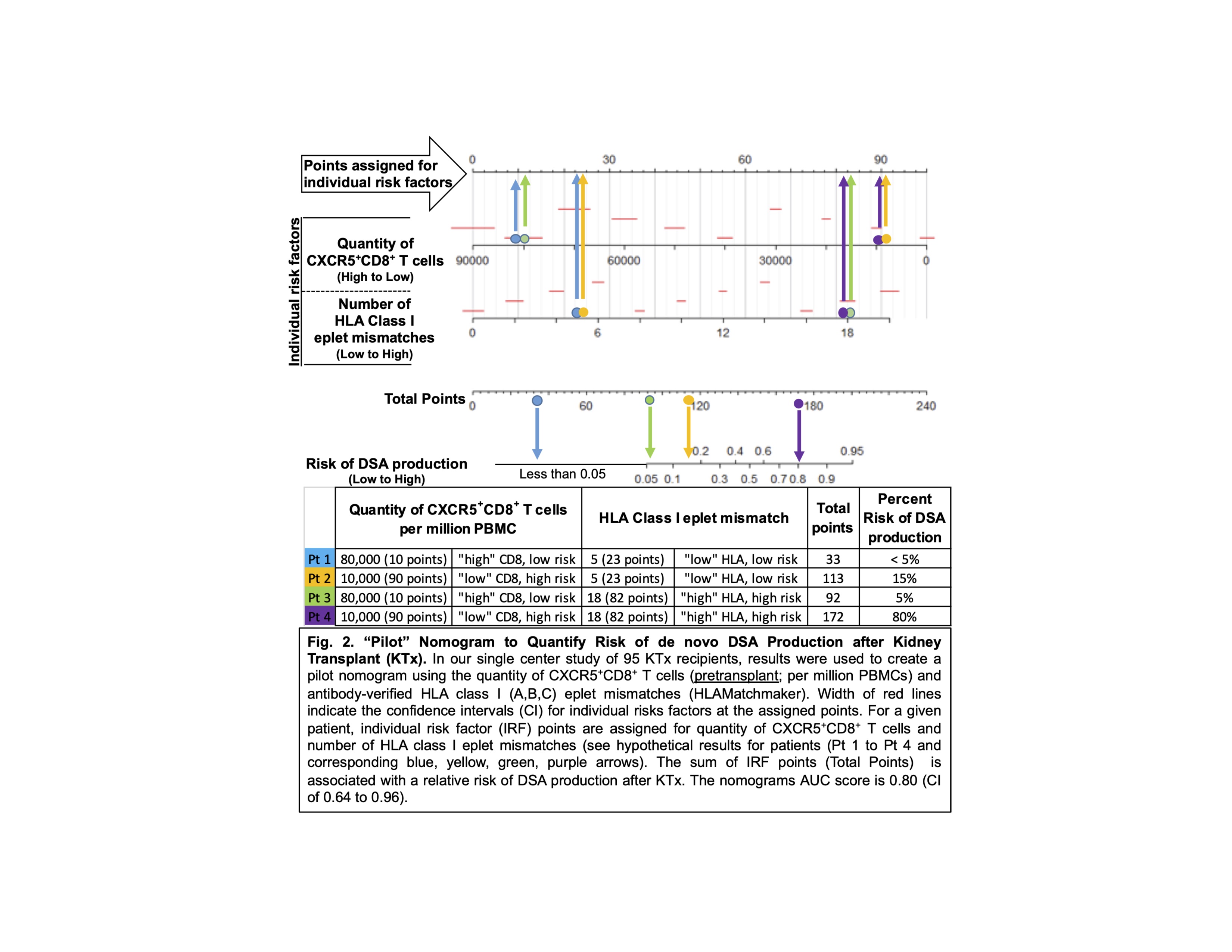Nomogram of Quantity of Peripheral Cxcr5+Cd8+ T Cells, Aims to Predict Risk of De Novo Dsa in First-time Kidney Transplant Recipients
1OSU, Columbus, OH, 2Center for Biostatistics, OSU, Columbus, OH
Meeting: 2021 American Transplant Congress
Abstract number: 681
Keywords: Antibodies, Kidney, T cells
Topic: Clinical Science » Biomarkers, Immune Assessment and Clinical Outcomes
Session Information
Session Name: Biomarkers, Immune Assessment and Clinical Outcomes
Session Type: Poster Abstract
Session Date & Time: None. Available on demand.
Location: Virtual
*Purpose: We recently reported that peripheral CXCR5+CD8+ T cells are inversely associated with the risk of developing de novo DSA (dnDSA) in the first year after kidney transplantation (Tx). Using data from our single center study we aimed to develop a pilot nomogram as a tool to determine risk of developing dnDSA.
*Methods: We prospectively monitored 95 first-time KTx recipients (53.3±11.8 years old, 41% female, 21% African American, 32.6% deceased donor recipients) for development of dnDSA for 1 year posttransplant using single antigen beads (MFI >2000). All recipients received the same immunosuppression (IS) regimen [ATG induction therapy, 5-day steroid taper, and dual maintenance IS with a calcineurin inhibitor (CNi) and mTORi]. In addition to the detection of dnDSA, we prospectively and serially analyzed recipients for IS levels, HLA and eplet mismatch, and peripheral blood mononuclear cell (PBMC) subsets.
*Results: Twenty-three recipients (24.2%) developed dnDSA within 1-year postTx. There was no difference in IS levels throughout the first-year postTx between DSA-positive and DSA-negative recipients. PreTx quantities of peripheral blood CXCR5+CD8+ T cells were inversely associated with the incidence of dnDSA (DSA+= 15,200±11,600 CXCR5+CD8+ T cells per million PBMCs vs. DSA-=26,300±17,600; p=0.04). PreTx quantity of CD4+ T cell subsets (Th1, Th2, Treg) were not associated with the incidence of de novo DSA. Although we did not find a significant difference in HLA mismatch between the DSA+ vs. DSA- KTx recipients (6.8±2.1 vs. 6.0±2.1; p>0.05), when we compared the more precise Ab-verified HLA eplet mismatches we found that the number of HLA class I eplet mismatches significantly associated with development of dnDSA at one year postTx (DSA+= 12.4±4.4 mismatches vs. DSA-= 8.6±4.1; p=0.006). In Figure 1, we use theoretical patient profiles for quantity of CXCR5+CD8+ T cells and number of HLA I eplet mismatches to demonstrate how the independent risk factors (IRF) used to develop this nomogram would influence the estimated percent risk for postTx DSA. Theoretical preTx quantity of CXCR5+CD8+ T cells and number of HLA I eplet mismatches were used to assign IRF points and total (combined risk factor) points that predict percent risk of developing dnDSA after KTx. This exercise demonstrates how patients with the same HLA related risk (HLA I eplet mismatch) could have disparate risk of dnDSA based on their preTx quantity of CXCR5+CD8+ T cells.
*Conclusions: Future prospective clinical studies are planned to assess and validate the accuracy of the nomogram.
To cite this abstract in AMA style:
Zimmerer J, Abdel-Rasoul M, Bumgardner G. Nomogram of Quantity of Peripheral Cxcr5+Cd8+ T Cells, Aims to Predict Risk of De Novo Dsa in First-time Kidney Transplant Recipients [abstract]. Am J Transplant. 2021; 21 (suppl 3). https://atcmeetingabstracts.com/abstract/nomogram-of-quantity-of-peripheral-cxcr5cd8-t-cells-aims-to-predict-risk-of-de-novo-dsa-in-first-time-kidney-transplant-recipients/. Accessed December 27, 2025.« Back to 2021 American Transplant Congress

